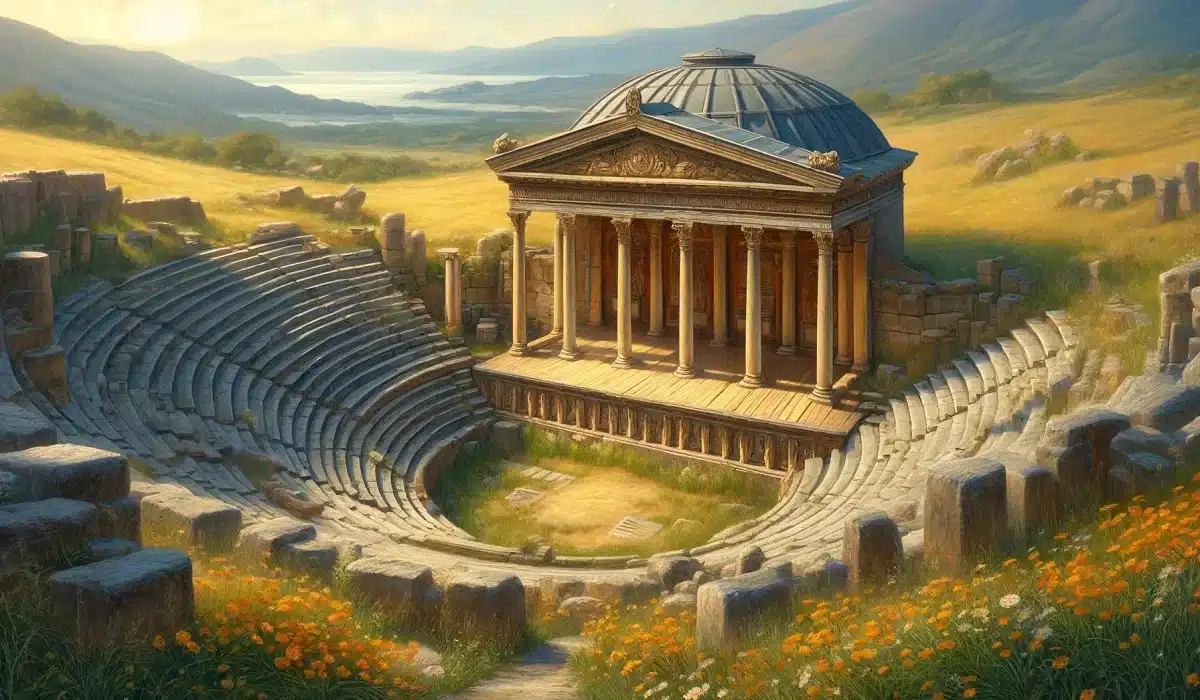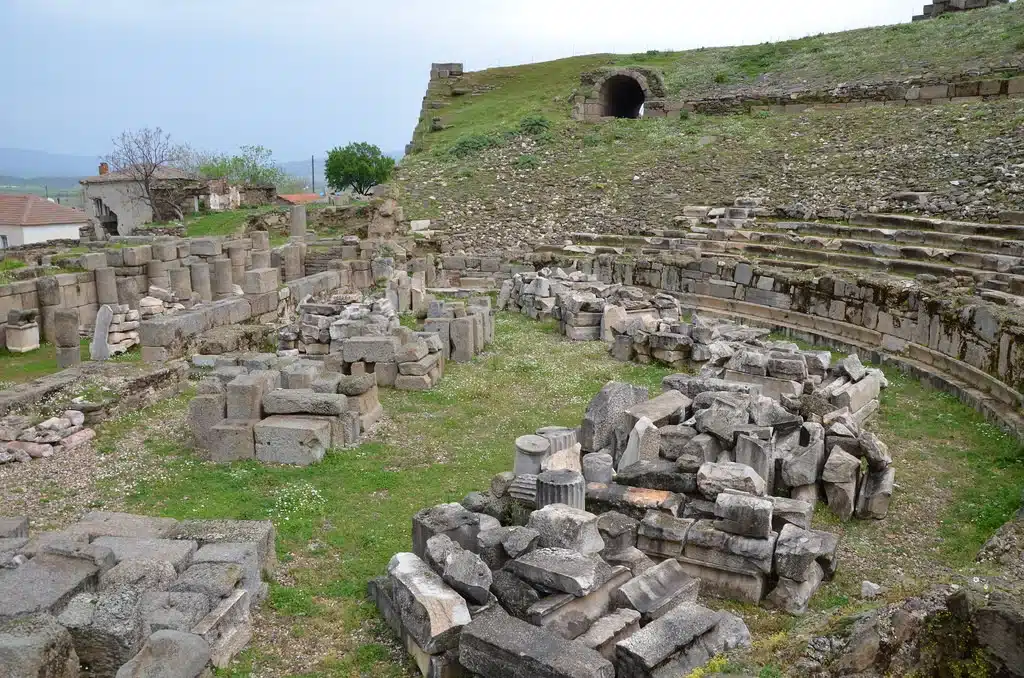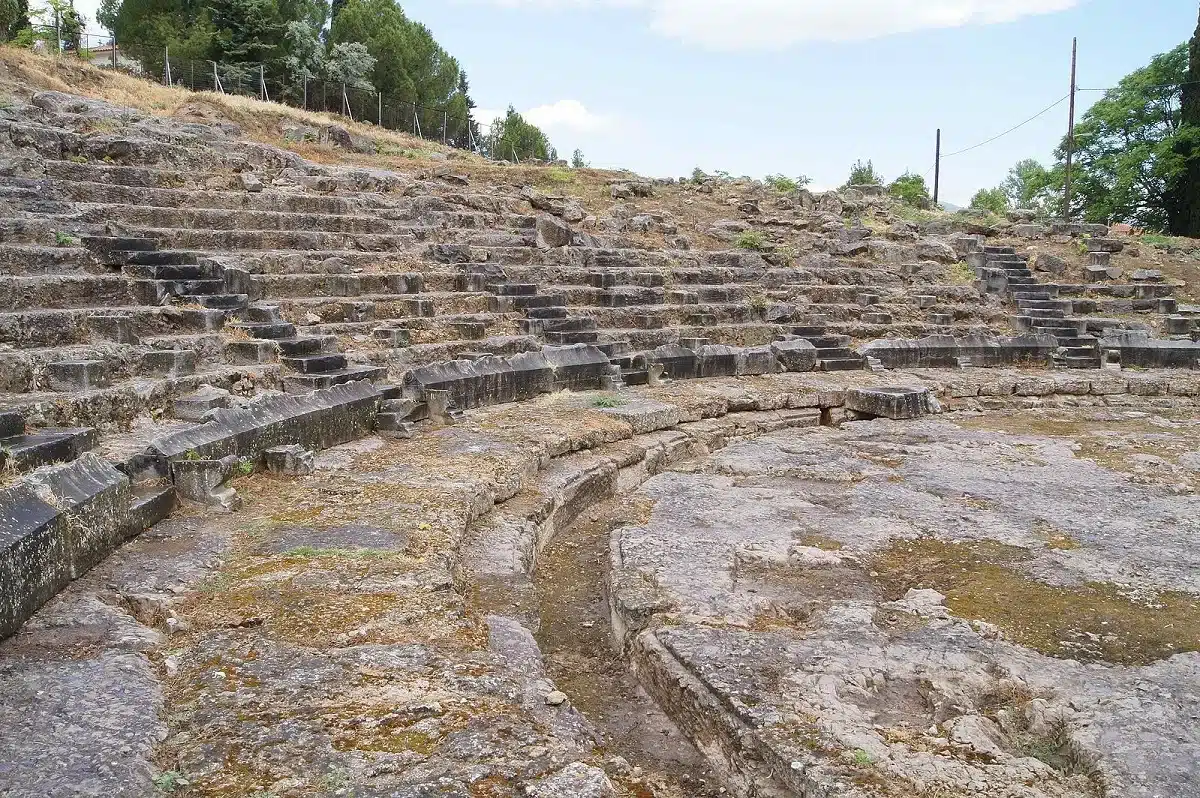An odeion is a type of enclosed structure used in ancient times for music, poetry readings, and small-scale theatrical performances. These structures, which generally have a semi-circular or rectangular plan, were popular in Greek and Roman civilizations and were designed for smaller and private communities, as opposed to large open-air theatres.
Odeions are known for their acoustic properties, and some famous examples can still be seen today, especially at archaeological sites around the Mediterranean. These historical structures provide valuable information about the cultural and artistic life of the ancient world, and preserving them allows us to better understand the artistic approach of past civilizations.

What is Odeion and Where is it?
Odeions are closed theater structures used for music, theater and sometimes political meetings during the Ancient Greek and Roman periods. These structures have played an important role in the cultural and social life of the civilization throughout history.
Definition and Purpose of Use of Odeion
The definition of odeion refers to an enclosed theater structure, usually with a semicircular seating and stage area. These structures were specially designed for musical concerts, poetry readings and theater performances in Ancient Greece and Rome. Additionally, events such as political meetings or philosophical discussions were also held in these structures.
Important Odeions in Ancient Greece and Rome
There are many important odeions in ancient Greece and Rome . For example, the Odeion of Herodes Atticus in Athens is a historic building still used for concerts and performances today. Additionally, the Odeion in Ephesus is known as one of the best-preserved theater buildings of the ancient world and attracts attention with its rich decorations.
Architectural Features of Odeions
The architecture of the odeions is quite remarkable in terms of acoustic features and audience arrangement.
Structural Design and Architecture
The structural design and architecture of odeions generally have a semicircular or elliptical form. These structures are built of stone or brick and are usually covered with a wooden roof. In its interiors, there is a large orchestra area in front of the stage, while the backstage is usually equipped with waiting areas and warehouses for the artists.
Acoustic Features and Audience Arrangement
The acoustic properties of Odeions are specially designed by the architects to ensure that sound waves reach all audiences equally. The dome or high roof structures of the building allow the sound to spread better. The audience arrangement generally consists of tiered seating rows and allows each audience member to easily see and hear what is happening on stage.
Historical Development of Odeions
Odeions played an important role in the ancient Greek and Roman civilizations as centers of music, theater and social events.
The emergence of the first Odeions took place in parallel with the development of music and theater in Ancient Greece. Initially, these structures were designed specifically for musical concerts and evolved over time to support more comprehensive cultural activities. While the first odeions were thought to derive from simple, open-air theatres, over time they turned into closed and more acoustic structures.
Important examples of odeions are usually located in major cities or cultural centres. The Odeion of Herodes Atticus in Athens, the Odeion of Pompeii in Italy and the Odeion in Ephesus are among the best-known examples of these structures. Each reflects periodic changes in architectural style and intended use. Structural and decorative developments have been seen in these buildings over time, and more complex acoustic features and decorations have been added.
Cultural and Social Role of Odeions
Odeions served not only as entertainment venues for the ancient world, but also as centers of education and social events.
The use of Odeions in entertainment and education demonstrates the diversity of activities in these structures. Odeions were used for dramatic plays, musical performances, and public lectures. Especially philosophers and teachers addressed large audiences in these places and had the opportunity to spread knowledge. This usage indicates that Odeions not only provide entertainment but also contribute to education and cultural development.
The importance of Odeions in social events and ceremonies draws attention among the various uses of these structures. Official ceremonies, state meetings and even some religious rituals were held in these places. Odeions served as central places where society came together to celebrate or discuss important events, thereby reinforcing social unity and integrity.
Preserved Odeions and Their Current Situation
Odeions present important examples of ancient world architecture, and many archaeological sites today still contain preserved versions of these historical structures.
Thanks to restoration work , many Odeions have been preserved or restored to close to their original splendor. For example, the Odeion of Herodes Atticus in Athens has undergone extensive restoration projects and is still used today for live performances such as concerts. The Odeion in Ephesus was made open to visitors through archaeological excavations and restoration works. Such works enable the Odeions to be opened to modern visitors while preserving their historical texture.
Most preserved Odeions are well organized for visitor information and accessibility . Information about visiting hours, entrance fees and tours is usually provided by the relevant museum or archaeological site managements. Additionally, these sites are often made accessible for disabled people, allowing everyone to explore these historical structures.
Reflections of Odeion Architecture in Modern Architecture
The architectural features of the ancient Odeions have also found echoes in modern architecture and have been a source of inspiration for many contemporary buildings.
Many modern buildings were designed with inspiration from Ancient Odeions. For example, many modern amphitheatres and concert halls around the world have adopted the semicircular seating and open stage design of the Odeions. These structures aim to provide the audience with a perfect sound experience by taking advantage of the acoustic properties of old Odeions.
The connections between ancient and modern architecture are not limited to aesthetic and structural similarities; They also share common features in terms of functionality and versatility. Modern architects carry the spirit of these historical buildings into contemporary designs, aiming for the multifunctional use of Odeions, that is, creating spaces suitable for both entertainment and social events. In this way, the ancient heritage is kept alive in the modern world.





